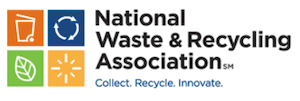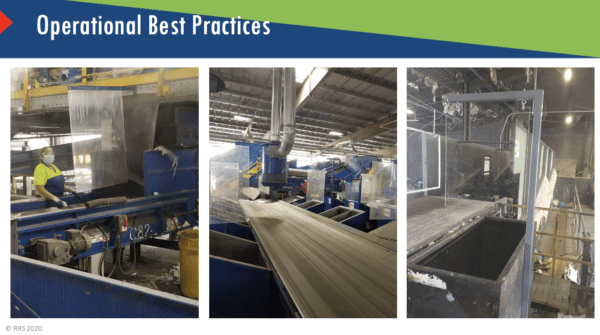Webinar Takeaways: Recycling Operations During COVID-19
The arrival of the novel coronavirus, COVID-19, caused many business sectors to act quickly—implementing new safety measures, making changes to operations and securing access to personal protective equipment (PPE). For the waste and recycling industry, which has been dubbed an essential service by the Department of Homeland Security, the pandemic brought a vast variety of new challenges, especially as waste industry employees continued to work on the frontlines to protect human health and the environment.
During a recent webinar hosted by the National Waste & Recycling Association, Pete Keller, vice president of recycling and sustainability at Republic Services, and Michael Timpane, principal and vice president at Resource Recycling Systems (RRS), discussed these challenges as well as operational best practices, volume impacts across lines of business, changes in material characteristics, contract and program implications, commodity considerations, managing operations through rapid and variable change and what the “new normal” may look like post-COVID-19.
Operational Best Practices
At Republic Services, the company has undergone a number of changes over the past few months, some of which will be temporary, and some of which will be permanent. From implementing more work from home options, to following social distancing measures, to ramping up cleaning efforts and access to PPE, to investing in advanced technologies and physical barriers, Republic continues to put into place best practices to keep both its employees and customers safe.
Keller pointed out how rapidly the shutdown took place across the country—essentially occurring within a two-week period. This naturally resulted in significant confusion about numerous things including whether recycling was even considered essential. “There was a lot of conflicting guidance early on relative to gloves, masks, how long the virus can last on surfaces, how the virus actually spreads, what was essential and what wasn’t, what was being enforced … and when you consider what our industry had to do in a very short period of time, I’m proud of what we were able to accomplish,” said Keller.
“We decided early on that we needed to manage risk, and we started with our people,” he added. “We employed measures inside our physical assets to provide services within our communities, [all while] making sure we got materials picked up in a manner that wouldn’t cause additional problems.”
One of the biggest challenges of working during the pandemic is that the industry is very labor intensive, with employees often working in close proximity to each other. In an effort to maintain social distancing, Republic Services installed physical barriers such as plexiglass in some of its recycling facilities, staggered start times and breaks for workers, provided employees with additional PPE and more.
As the nation starts to reopen, Republic continues to follow these best practices in an effort to maintain safe working environments.
Volume Impacts and Material Characteristics
For the past few months, non-essential businesses have remained temporarily shuttered, and many shelter-in-place orders have been extended. These factors, along with others, have led to an uptick in residential waste and recycling volume, and a decrease in most commercial volume, in particular hospitality and office buildings. However, some commercial facilities experienced increased volumes including grocery stores and, as can be expected, multifamily homes.
Of this volume, the majority of materials are small cardboard from online purchases as well as aluminum, glass and polyethylene terephthalate due to some deposit systems being temporarily paused.
This increase in volume, however, has not been the easiest to manage, as 146 recycling programs were suspended due to COVID-19 concerns, worker safety, workforce limitations, hauler and facility decisions and prioritization of services. These suspensions impacted 3 million households, and approximately 6 percent of recycling tons.
With the nation slowly opening back up, 55 percent of those recycling programs have now resumed, providing services once again to about 1.4 million households.
Productivity of the MRF
Materials recovery facilities (MRFs) are valuable to the industry and to the economy, and in an effort to track their productivity, many operators measure in tons because they sell in tons. However, not all metrics trend in the same direction, so different measurements are used for different metrics.
For those who aren’t feeling secure during this time, or other difficult economic times, Timpane suggested keeping costs as tight as possible by increasing productivity.
Looking to the future, Keller stated that operators are generally building bigger facilities with less man-hours per ton of throughput, and this is a trend that will likely continue.
Commodity Changes
As COVID-19 spread quickly throughout the U.S. during the start of 2020, consumers raced to stock up on disposable paper items like toilet paper, tissues, paper towels and wipes, even though the coronavirus isn’t known to cause digestive issues. This “paper panic” has since slowed, as the number of confirmed COVID-19 cases continues to decrease in many areas.
Other commodities the industry has kept its eye on are aluminum, plastics, old corrugated cardboard, residential papers and news and mixed paper, all of which have experienced changes due to the impact of COVID-19.
While all commodities fluctuate with the economy, single stream is one of the most volatile, previously registering at a 50 percent annual volatility, according to Timpane. In comparison, other commodities such as gold registered at only 14 percent volatility, increasing with coking coal, platinum, aluminum, thermal coal, copper and iron ore until reaching the second highest volatile commodity, oil, at 43 percent. This is not new with the pandemic; however, COVID-19 drove volatility further.
Looking Ahead
Throughout the pandemic, there have been many lessons learned. And as industry leaders look toward the future, it’s important to note that contracts and operations may differ based on open market and franchise scenarios.
There will likely be tighter municipal budgets, higher processing costs, some canceled or potentially delayed mill capacity and other challenges brought upon by the broader economic recovery. All of these factors will influence conversations that companies will need to have with customers in the near future.
Interested in learning more? Listen to this recording of the webinar.


